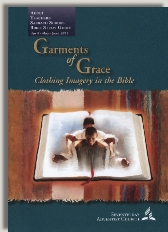|
||||||||||||||
Commentary on "The Coat of Different Colors"
Day 7: Friday, April 22, 2011 - Further Study
Overview
Finally the author writes something related to “garments of grace”: the readers are encouraged to look for parallels between Joseph and Jesus. This challenge is sandwiched between two moralistic impulses, one directed toward identifying modern “coats of many colors” and the other toward preventing a fall into similar moral failures. Proportionally the space given to moral lessons doesn’t fit with the overall goal of the quarterly, namely, the focus on “garments of grace”, not on moral purposes.
Observations
The lesson ends with questions shot in a machine-gunfire style. The common theme in these questions is "how". The final words of the lessons pass to the readers the task of figuring out how to think before acting, how to pray, how to die to self, how to surrender to the Lord in faith and obedience, and how to learn not to fall into the same trap Joseph’s brothers had fallen. This “how” reveals the author’s understanding of the problem of sin and its solution. “For sin will have no dominion over you, since you are not under law but under grace” (Romans 6:14). Instead of directing people toward grace, the "how" questions point in the opposite direction, toward law, toward doing instead of receiving. The problem is identified with a lack of practical knowledge, how to do the right surrender, how to pray correctly, how to die to self. These are imperatives, commands to be obeyed, and imperatives without the indicatives of the gospel are impossibilities.
When confronted with the problem of sin in believers, Saint Paul doesn't advise his readers to look after better and improved ways of praying, surrendering, and dying to self. Instead he tells them that in Christ they already died to sin and self:
"How can we who died to sin still live in it? Do you not know that all of us who have been baptized into Christ Jesus were baptized into his death?" (Romans 6:2).
It's impossible, Paul says, for believers to live in sin because they died to sin. "Don’t you know?" asks Paul, expecting his readers to know what he's talking about. Christ's death, burial and resurrection brought death to sin and newness of life. You can’t live in sin; it's impossible after you have been raised with Christ in newness of life to go back to a state of spiritual death. So now, get over it! Now get on and live the Christian life.
The command to live the Christian life, the imperative, is rooted deeply in the indicative, in the truth of being dead to sin and raised with Christ, in the truth that believers are under grace, not law. "For sin will have no dominion over you, since you are not under law but under grace." (Romans 6:14). The law pronounces a curse on everybody who doesn't fulfill it perfectly (Galatians 3:13); it threatens to cut people off from life; there is no solid terrain under their feet.
Under grace, the curse is removed through Jesus' death and resurrection (Galatians 3:13), and now believers are told to act in harmony with what they already are in Christ: holy. The solution is not in doing things differently, in developing new abilities regarding dying to self, but in recognizing that in Christ believers already died to self and sin and also in Christ they are spiritually alive, once and for all time. When they are commanded to submit to Christ, the crucial point is that this submission is not the means of obtaining spiritual life, but it’s done from the position of already possessing spiritual life: "Do not present your members to sin as instruments for unrighteousness, but present yourselves to God as those who have been brought from death to life, and your members to God as instruments for righteousness" (Romans 6:13).
That's how submission to God is to be done, if indeed what believers lack is a right methodology. The right methodology is to believe first the gospel, that in Christ's death, burial, and resurrection something decisive and irreversible happened, a transition from death to life, from the domain of darkness to the domain of light (1 Peter 2:9), something that cannot be done as long as people are the prisoners of the law's "Do this and live" (Galatians 3:12, Romans 10:5) and “don’t do and die”. Christ bore this curse and brought eternal life; believers now live on the side of heaven, not on the side of death.
On this objective accomplishment, on this indicative, the imperative of obeying is built. Believers live holy lives because they are holy; they put sin to death because they are already once and for all dead to sin. More, their old life is buried, done, over. Believers live in newness of life because they have been raised with Christ from the tomb (Romans 6:3,4), once and for all time.
Copyright 2011 BibleStudiesForAdventists.com. All rights reserved. Revised April 20, 2011. This website is published by Life Assurance Ministries, Glendale, Arizona, USA, the publisher of Proclamation! Magazine. Contact email: BibleStudiesForAdventists@gmail.com.
The Sabbath School Bible Study Guide and the corresponding E.G. White Notes are published by Pacific Press Publishing Association, which is owned and operated by the Seventh-day Adventist church. The current quarter's editions are pictured above.
Official Adventist Resources
Standard Edition Study Guide Week 4
Teacher's Edition Study Guide Week 4
Easy Reading Edition Study Guide Wk 4
Search the Complete Published Ellen G. White Writings
Please Support This Project


